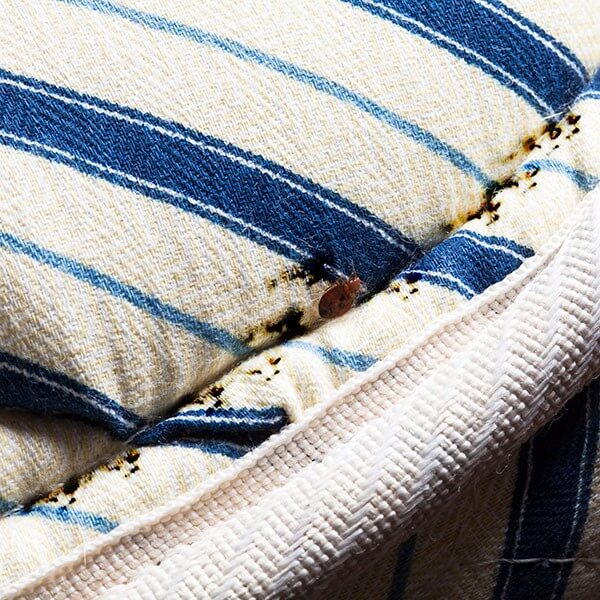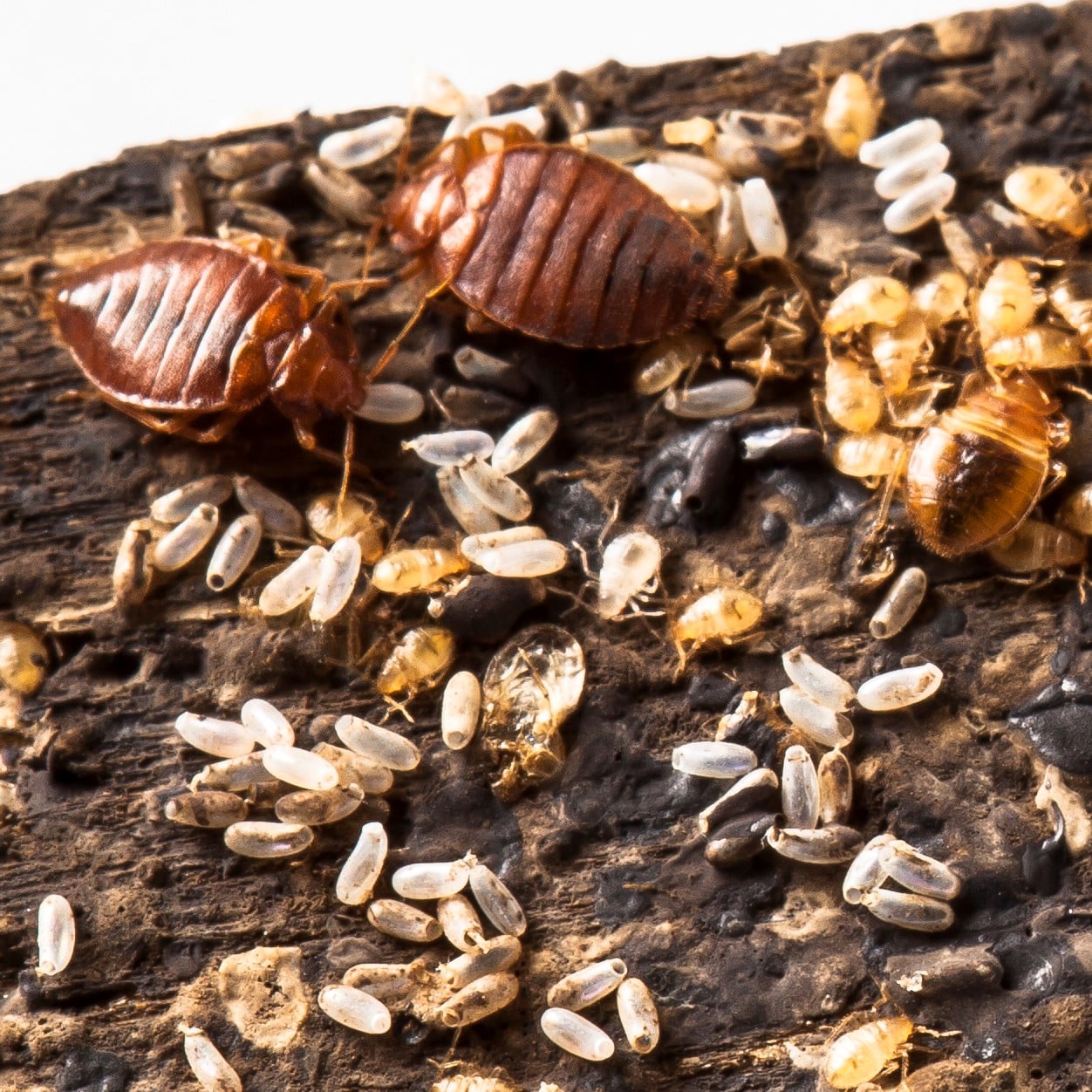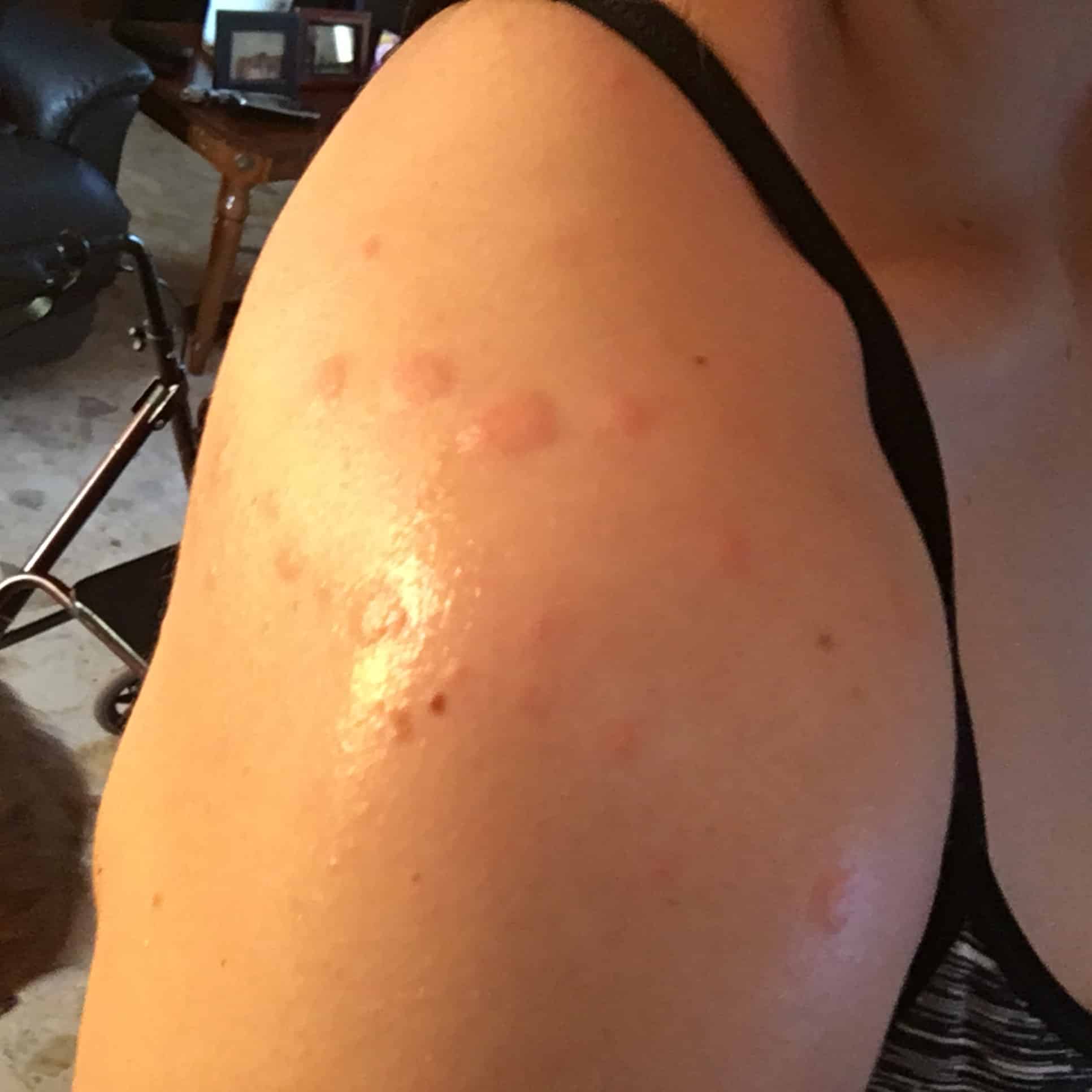
In the article
Last Updated on 07/01/2025 by Tony Abrahams
7 Early Signs Of Bed Bugs
Look out for these telltale signs:
- Bites: Red, itchy bites, often in a line or cluster
- Blood Stains: Tiny blood spots on your sheets from squished bugs
- Fecal Matter: Little black spots or dark red stains (yep, that’s their poop)
- Shed Skins: Light brown, see-through skins left behind by growing nymphs
- Eggs: Small, whitish eggshells in mattress seams and furniture cracks
- Live or Dead Bed Bugs: Small dark brown, wingless insects (5mm)
- Smell: A musty odor, like a wet towel, suggests a significant bed bug infestation.
During the day, bed bugs hide in the nooks and crannies of your bed, bed bases, headboards, and bed frames. They also love to hang out in mattress seams, couch cushions, and drawers.
By spotting these early signs, you can tackle the problem before it gets out of hand.
What Do Bed Bugs Look Like?
Bed bugs are tiny, reddish-brown critters that love to snack on human blood. They’re about the size and shape of an apple seed. Here’s the lowdown:
- Color: Reddish-brown
- Shape: Flat and oval shaped in unfed, but become tubular and red after feeding
- Size: Around 5-7 mm long
- Wings: They’re wingless
- Behavior: Noctural, they come out to feed when you’re asleep
Bed bugs start as see-through nymphs and turn dark brown after their first meal. Spotting adults, eggs, and nymphs early can save you a lot of headaches.

Early Signs of Bed Bugs
Bed Bug Bites
Getting a handle on bed bug bites is key to spotting an infestation. These bites can look different and cause various reactions depending on the person.
What Bed Bug Bites Look Like
Bed bug bites usually show up as small, red bumps on your skin. They often appear in clusters or lines, a telltale sign of bed bugs. You’ll often find them on areas that are exposed while you sleep, like your face, neck, hands, and arms.
| Where You’ll Find Them | What They Look Like |
|---|---|
| Face, Neck, Hands, Arms | Small, red bumps |
| Back, Shoulders | Clustered or lined up |
The bites might take up to two weeks to show up, though some folks see them right away. This delay can make it tricky to figure out what’s causing the bites.
How People React to Bed Bug Bites
Reactions to bed bug bites can be all over the map. Some people get really itchy and inflamed, while others might not notice anything. In worse cases, people can get blisters or hives from an allergic reaction.
Bed bug bites can also mess with your sleep and cause anxiety because of the itching. Sometimes, bites can get infected if you scratch them too much.
For more tips on spotting and dealing with bed bug bites, check out our guide on how to check for bed bugs. Also, knowing the physical traits of bed bugs can help you catch them early and get rid of them faster.

Bed Bug Bites
Where Bed Bugs Hide
Knowing where bed bugs like to hang out and what they do during the day is key to catching them early. These sneaky critters are pros at finding hidden spots to chill, so you gotta know where to look.
Common Hiding Spots
Bed bugs are like ninjas when it comes to hiding. They love to set up camp in places where people sleep or relax. Here are some of their favorite hideouts:
- Mattresses and Ensemble Bases: Bed bugs love the seams, tags, and folds of your mattress and box springs.
- Bed Frame: Bed slats are a preferred nesting area because they are protected from bing squashed.
- Couch Cushions: They can be found in the seams and under the cushions of your couch.
- Cracks and Crevices: Bed bugs hide in cracks in wooden trim, behind baseboards, and around window and door mouldings.
- Clothing and Linens: They can infest your clothes, linens, and even the inside of dresser drawers.
- Wall Voids: Bed bugs may hide within wall voids and behind electrical outlets.
- Under Clutter: Cluttered areas are like a bed bug paradise.
These spots let bed bugs stay hidden, so it’s important to check them often. For more tips on spotting bed bugs, check out our article on how to check for bed bugs.
Tools to Find Bed Bugs
There are several ways to detect bed bugs early. From good old-fashioned visual checks to high-tech gadgets and even specially trained dogs, you’ve got options.
Macro Lenses for Smartphones
A macro lens for your smartphone can turn you into a bed bug detective. These lenses let you take super detailed photos of tiny pests, making it easier to confirm if you’ve got a problem. Clear images can help you plan your next steps.
Detection Dogs
Dogs with a nose for bed bugs can be incredibly accurate, with detection rates between 44% and 97%. These trained pups can sniff out live bugs and their eggs, even in hard-to-reach places. Using dogs along with visual inspections gives you a thorough check.
For more tips on spotting bed bugs, check out our guide on how to check for bed bugs. Knowing the early signs and using the right tools can keep your home pest-free.
Flashlight
A flashlight is essential for spotting bed bugs because it illuminates dark, hidden areas where these pests often reside. Using a flashlight helps you thoroughly inspect mattresses, furniture, and bed bases, ensuring you don’t miss any signs of an infestation.
Treatment and Extermination
So, you’ve spotted the early signs of bed bugs. Now what? It’s time to kick these unwelcome guests out of your home. There are a few ways to do this, from eco-friendly options to calling in the pros.
Non-Toxic Killer Powders
One of the best non-toxic ways to deal with bed bugs is using Bed Bug Killer powder. This stuff is made from amorphous silica, also known as Diatomaceous Earth Dust (DED). It works by dehydrating the bugs, and they can’t build up a resistance to it. Plus, it’s odorless and invisible once applied, so it won’t mess with your home’s vibe.
Why choose Bed Bug Killer Powder? Here’s why:
- Safe for kids and pets
- Works long-term with just one application
- No need for high heat or nasty chemicals
- Easy to apply, takes less than 30 minutes per room
Bed Bug Barrier products are scientifically tested and proven to be 100% effective. Experts recommend it, and it’s backed by the Australian Pesticides and Veterinary Medicines Authority (APVMA).
Check Out IOur Bed Bug Removal Methods
Professional Extermination Services
If your bed bug problem is out of control, you might need to call in the pros. Pest control companies offer different methods like heat treatments, chemical treatments, or a mix of both. Pine State Pest Solutions, for example, specializes in getting rid of bed bugs using these methods.
What do professional exterminators bring to the table?
- Expertise in spotting and treating bed bugs
- Advanced equipment and techniques
- Comprehensive plans to make sure the bugs are gone for good
Want to know more about identifying bed bugs and where they hide? Check out our articles on what do bed bugs look like and can you see bed bugs.
How to Get Rid of Bed Bugs On A Bed Frame
How To Get Rid Of Bed Bugs On An Ensemble Bed
How To Prevent Bed Bugs
1. Check Hotel Beds. When you stay at a hotel, always look at the mattress and bedding. Look for tiny blood spots, dark poop stains, or little bugs.
2. When You Return From Traveling: When you get home, wash all your clothes in hot water and clean your luggage. If you can’t wash something, put it in a plastic bag and freeze it for four days to kill any bugs.
3. Avoid Second-Hand Furniture or Mattresses: Don’t bring old furniture or mattresses into your home. They might have bed bugs.
4.Diatomaceous Earth (DE): Put DE around power points and electrical outlets to stop bed bugs from getting in from other places.
5. Apply DE to Your Bed Frame: Putting DE on your bed frame is a great way to stop bedbugs because it keeps working until you clean it off.
6. Guests: If you have guests who have been traveling, wash their clothes in hot water and clean their luggage. They might accidentally bring bedbugs into your home.
7. New Housemates: If you have new housemates who stayed in backpacker hostels, wash their clothes in hot water and clean their luggage to keep bedbugs out.
Following these steps will ensure they are effectively eliminated from your bed and room, allowing you to sleep peacefully, knowing you’re protected. To find out more about our products check out our bed bug product page.
Frequently Asked Questions:
- How do you know if bed bugs are starting?
Early signs of bed bugs include small, red, itchy bites on your skin, tiny blood stains on sheets or pillowcases, dark spots of excrement, eggshells, shed exoskeletons, or a strong, musty odour. - How long do you have bed bugs before you know it?
Bed bugs can go unnoticed for weeks to months. Detection time depends on your skin’s reaction to bites or when you see other signs like live bed bugs. - What is the beginning stage of a bed bug?
Bed bugs start as tiny, pearly white eggs hidden in mattress seams, bed frames, and cracks. After hatching, they enter the nymph stage, going through five moults before becoming adults.
Sources:
Medical News Today (Bed bug bites: What you need to know), Mayo Clinic (symptoms causes), Orkin (where do bed bugs hide)



Leave a Reply